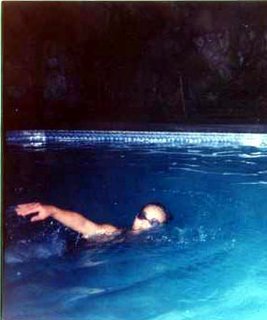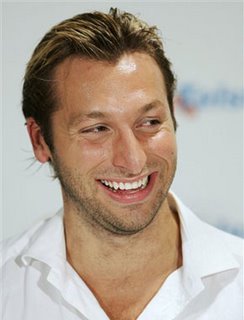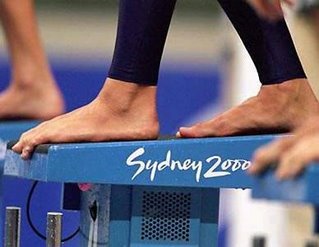
Today was my “make up” meet in Nanaimo, hosted by the Nanaimo Ebbtides. After a restful 1½ hour ferry trip from Horseshoe Bay the Ebbtides picked me and some other competitors coming over as foot passengers up at the terminal and took us to the Aquatic Centre. There I joined with two other Hyack swimmers who’d gone over the previous night. Not many, but our participation was still a three-fold improvement over last year. Quality not quantity right? Another modern 50 meter pool almost identical to Coquitlam CCAC, the Nanaimo Aquatic Centre also uses elevated flooring to create a shallow area when required. The water, though, is kept at competition temperature (i.e. cold), somewhat unusual these days and times when pools seem to cater to the recreational public who demand warmer temperatures. Admittedly they keep the ‘recreation pool’ which includes their wave pool and other attractions at bath temperature. It would be interesting to see the available studies on the effects of water temperature on pool revenue and how it’s affected by utilizing supplementary pools at alternate temperatures (I’m an accountant – these things fascinate me). The pool configuration for the meet was short course (sc) which provided a very convenient 25 meter pool in the other half for warm up during the meet itself.
 Entering Nanaimo Harbour on the Horseshoe ferry run
Entering Nanaimo Harbour on the Horseshoe ferry runMy first race was the 100 breast, for me a throw-away event, so no real pressure on me other than a natural desire to do well. Even so, the time I set for this race is going to be around for a long time as I’m extremely unlikely to race this event again during this season. All I was hoping to do was come close to my target time and then rest up for my free and back races. Not helping was the discovery my psych time on the meet program was three seconds faster than I thought I had put down. Now I was concerned about embarrassing myself (again) by swimming too slowly. Yet the race itself went pretty well to plan, my intention to set a strong pace at the beginning (i.e. not fast!) and hang on to the end concentrating on technique. Started getting tired around the sixty five meter mark but by pushing the last twenty five I finished in reasonable shape. My time, surprisingly enough, was a couple of seconds better than my posted psych time. An excellent start to my day!

My second race was the 100 free. Here my plan was to swim a negative split – go out under control and then let it out the last fifty. The first fifty was fair though my swimming technique, especially my body’s streamlining, was poor. My head was bobbing up and down like a cork as I first looked ahead towards the wall and then tried correcting myself to look down at the lane line, only once there to wonder where that damn wall was and take a quick peek! I know my turns are atrocious so they tend to distract me inordinately. Of course ever so concerned about my turns, I almost missed my first, thereby ensuring I’d race absolutely paranoid about the remaining two. Swimming down the lane I wasn’t thinking about breathing, hand placement, my pull, or even about my kick; I was just thinking to myself, “DON’T MISS THE TURN! DON’T MISS THE TURN!” In the second fifty, abetted by increasing fatigue, my technique just disintegrated – my last lap seeing me throw out any pretense of style and efficiency and simply flailing as fast as I could. It wasn’t pretty. My time, however, was in the upper range of my target time, and I can take some very real comfort I have so very, very many things to improve.
My last race was the 100 back, the race to redeem my UBC fiasco. No little pressure here – getting ready to jump in I was wondering what someone must feel like getting on the starting block in the Olympics. Really, who needs competitors when I can do just fine psyching myself out! The race? Well, I didn’t butcher a turn at least (my teammates apparently beg to differ) but, like my freestyle, my backstroke technique was simply awful and I ran into the rope once. Ending really tired, actually surprisingly tired, my time was only a little more than a second faster than my UBC result so a very disappointing finish. Just not missing a turn should have meant more time off so I was actually slower in Nanaimo than at UBC. Later upon reflection I realized my lack of conditioning was partly at fault as I had swum two races in the preceding two and a half hours before, clearly adversely impacting my time. Plus I didn’t have Ian to bring me out in the first fifty at the right pace and so held back too much. Rather than beat myself up for not improving enough over two weeks I should take some solace my result was in range of my original UBC target time. If I had performed this well just two weeks ago at UBC I’d have been very pleased with the result. I just have to work harder and concentrate on my swimming technique more. I must push Brad for another stroke clinic soon.
As for my two teammates Damien had given himself the ambitious itinerary of 100 fly and the 200 IM, more of an exploration as he hadn’t raced these two events in years, and acquitted himself well. Joe, who had actually come down with a bad cold the evening before, did even better and set a personal best (Masters) in his favourite event the 50 free, as well as putting in good times in the 50 back and breast. All in all a good meet. The pool is fast and the meet was very well managed. I’ll be sure to go next year.

Before leaving I would be remiss, what with Christmas season in full play, if I didn’t give everybody who reads this the opportunity to experience the town of Nanaimo’s namesake treat, the
Nanaimo Bar. This is truly one of the finest cookies you can make; the treat has an almost universal appeal, and taste is so good you can almost ignore the calories. In the Pacific Northwest it’s referred to as the ‘legendary’ Nanaimo Bar and you find it everywhere, wrapped in its ubiquitous plastic wrap, right next to the chocolate bars and other desserts. Simple to make too, be sure to try the recipe out!
 By fifty the average person will have lost 10% of his or her muscle mass along with a corresponding decrease in strength, and by seventy this loss will have risen to 40%. The resulting decline in strength is the primary cause of the high incidence of accidental falls seen among the elderly. It also contributes to our institutionalization when motor skills become insufficient to deal with normal day-to-day living requirements. Furthermore sarcopenia is linked to increased tendencies towards obesity, glucose intolerance, osteoporosis, and the inability to regulate body temperature; all effects of having less muscle – the body’s most metabolically active tissue – present.
By fifty the average person will have lost 10% of his or her muscle mass along with a corresponding decrease in strength, and by seventy this loss will have risen to 40%. The resulting decline in strength is the primary cause of the high incidence of accidental falls seen among the elderly. It also contributes to our institutionalization when motor skills become insufficient to deal with normal day-to-day living requirements. Furthermore sarcopenia is linked to increased tendencies towards obesity, glucose intolerance, osteoporosis, and the inability to regulate body temperature; all effects of having less muscle – the body’s most metabolically active tissue – present. There are likely several factors contributing to sarcopenia: loss of nerve cells from aging or HIV causing the associated muscle cells to be lost as well, diminished hormone levels, an impaired immune system, or diets with insufficient protein, all inhibit muscle growth and contribute to its loss. But by consensus the primary cause of muscle loss is simply not using them. The old saying “if you don’t use it you lose it” applies here in spades. Even more alarming for women studies have shown there's a strong
There are likely several factors contributing to sarcopenia: loss of nerve cells from aging or HIV causing the associated muscle cells to be lost as well, diminished hormone levels, an impaired immune system, or diets with insufficient protein, all inhibit muscle growth and contribute to its loss. But by consensus the primary cause of muscle loss is simply not using them. The old saying “if you don’t use it you lose it” applies here in spades. Even more alarming for women studies have shown there's a strong correlation between sarcopenia and those who have lower levels of musculature to begin with. So the trick is to ‘bank’ some muscle when young and then maintain it by regular exercise as you grow older. Study after study has shown physical activity, with weight training of sufficient intensity being cited as particularly effective regardless of one’s age, is the key to reducing the rate of inevitable muscle loss as we grow older.
correlation between sarcopenia and those who have lower levels of musculature to begin with. So the trick is to ‘bank’ some muscle when young and then maintain it by regular exercise as you grow older. Study after study has shown physical activity, with weight training of sufficient intensity being cited as particularly effective regardless of one’s age, is the key to reducing the rate of inevitable muscle loss as we grow older.






.jpg)



















.jpg)